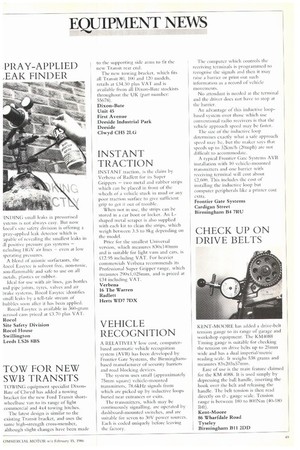VEHICLE RECOGNITION
Page 49

If you've noticed an error in this article please click here to report it so we can fix it.
A RELATIVELY low cost, computerbased automatic vehicle recognition system (AVR) has been developed by Frontier Gate Systems, the Birminghambased manufacturer of security barriers and road blocking devices.
The system uses small (approximately 75mm square) vehicle-mounted transmitters, 78.6kHz signals from which are picked up by inductive loops buried near entrances or exits.
The transmitters, which may be continuously signalling, are operated by dashboard-mounted switches, and are suitable for seven to 30V power sources. Each is coded uniquely before leaving the factory. The computer which controls the receiving terminals is programmed to recognise the signals and then it may raise a harrier or print out such information as a record of vehicle movements.
No attendant is needed at the terminal and the driver does not have to stop at the barrier.
An advantage of this inductive loopbased system over those which use conventional radio receivers is that the vehicle approach speed may be faster.
The size of the inductive loop determines exactly what a safe approach speed inay be, but the maker says that speeds up to 32km/h (20mph) are not difficult to accommodate.
A typical Frontier Gate Systems AVR installation with 10 vehicle-mounted transmitters and one barrier with receiving terminal will cost about 0,600. This includes the cost of installing the inductive loop but computer peripherals like a printer cost extra.
Frontier Gate Systems Cardigan Street Birmingham B4 7RU






















































